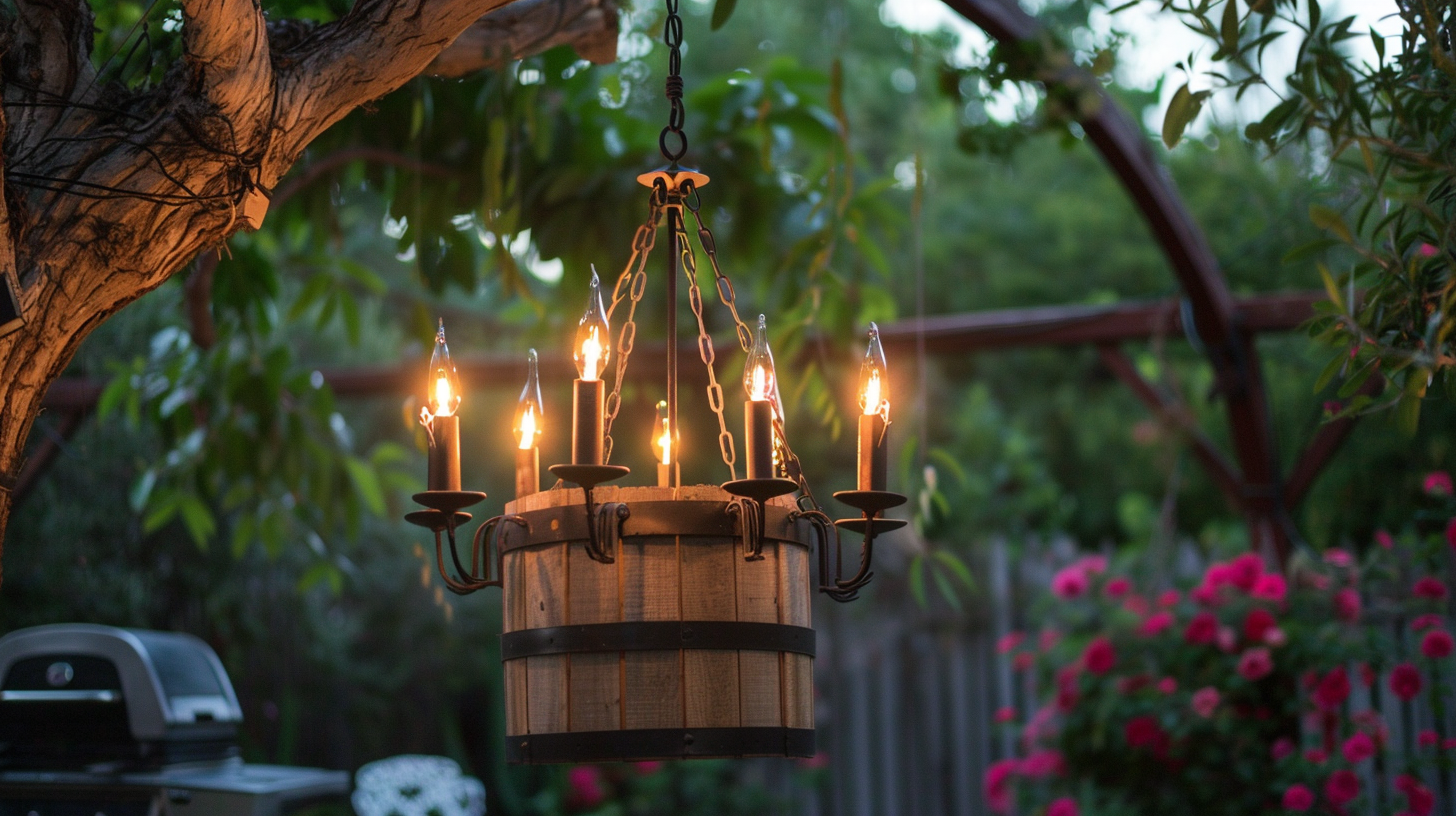In this article, we will guide you through the process of building your own outdoor chandelier, allowing you to add a touch of elegance and illumination to your outdoor space. From selecting the right materials to planning the design and layout, we will provide step-by-step instructions and expert tips to ensure a successful project. Discover the necessary tools and techniques for wiring, installation, and maintenance, and transform your outdoor area into a stunning and inviting space.
Choosing the Right Materials for Your Outdoor Chandelier
When selecting materials for your outdoor chandelier, it is crucial to consider durability and weather resistance. The materials you choose will not only determine the longevity of your chandelier but also its ability to withstand harsh outdoor conditions. Durability is key, as your chandelier will be exposed to elements such as rain, wind, and sunlight. Opting for materials like stainless steel, aluminum, or brass can ensure that your chandelier remains intact and functional for years to come. Apart from durability, aesthetics also play a significant role. Choose materials that complement the overall design of your outdoor space and enhance its visual appeal. Additionally, budget considerations should not be overlooked. It is important to strike a balance between quality and cost when choosing materials. Lastly, sourcing sustainable materials can be a responsible choice, reducing the impact on the environment.
Planning the Design and Layout of Your Outdoor Chandelier
To ensure a cohesive and visually appealing outdoor space, it is essential to carefully plan the design and layout of your outdoor chandelier, combining functionality and aesthetic appeal. When considering the layout of your outdoor chandelier, there are several important factors to take into account. First, determine the size and scale of your outdoor space. This will help you determine the appropriate size and placement of your chandelier. Consider the height of the ceiling or structure where the chandelier will be installed, as well as the surrounding landscape and architecture. Additionally, consider the function of the chandelier. Will it primarily serve as ambient lighting or task lighting? This will impact the type and intensity of the light fixtures you choose. By carefully considering these layout considerations, you can create a well-designed and visually pleasing outdoor lighting design.
Gathering the Necessary Tools and Equipment
The builder’s checklist should include all of the necessary tools and equipment for assembling the outdoor chandelier. Gathering tools before starting the project is essential to ensure a smooth construction process. Some of the tools that should be included in the checklist are a ladder, pliers, wire cutters, a screwdriver set, and a level. These tools will help in the installation of the chandelier and ensure its stability and durability. Additionally, safety precautions should also be taken into consideration. It is important to wear protective gear such as gloves and safety goggles to prevent any accidents or injuries. Following the manufacturer’s instructions and taking necessary safety measures will ensure a successful and safe assembly of the outdoor chandelier.
Preparing the Base Structure for Your Chandelier
After gathering the necessary tools and equipment, the next step is to carefully construct the base structure for your chandelier, ensuring its stability and functionality. Base structure preparation is a crucial aspect of building an outdoor chandelier as it provides the foundation for the entire fixture. It is essential to select the appropriate materials and design the structure in a way that can withstand outdoor conditions such as wind, rain, and temperature changes. The base structure should be sturdy and durable, capable of supporting the weight of the chandelier and any additional elements such as hanging plants or decorations. Additionally, the hanging mechanism selection is equally important to ensure that the chandelier is securely suspended from its intended location. The hanging mechanism should be able to withstand the weight of the chandelier and provide stability to prevent any accidents or damage. Careful consideration and attention to detail during the base structure preparation and hanging mechanism selection are key to creating a functional and visually appealing outdoor chandelier.
Wiring and Electrical Considerations for Outdoor Use
When it comes to wiring and electrical considerations for outdoor use, there are a few key points to keep in mind. Firstly, it is important to ensure that all electrical connections are weatherproof to protect against moisture and other outdoor elements. Additionally, proper grounding is crucial for safety purposes, as it helps prevent electric shocks and other hazards. Lastly, it is essential to consider the power supply options available, such as solar or low-voltage systems, to ensure efficient and cost-effective outdoor electrical usage.
Weatherproof Electrical Connections
Ensure the safety and longevity of your outdoor chandelier by employing proper techniques for weatherproofing electrical connections. When it comes to outdoor wiring techniques, one of the most important considerations is using waterproof connectors. These connectors are specifically designed to protect electrical connections from moisture, preventing corrosion and potential electrical hazards. When installing your outdoor chandelier, it is crucial to use these connectors to ensure that all connections are properly sealed and protected from the elements. Additionally, it is essential to follow the manufacturer’s instructions and guidelines for weatherproofing electrical connections. This may include using silicone sealants or weatherproofing tape to further protect the connections from water damage. By taking these steps, you can ensure that your outdoor chandelier will withstand the outdoor elements and provide beautiful illumination for years to come.
Grounding for Safety
One important consideration for outdoor electrical installations is the use of proper grounding techniques to prevent electrical hazards. Grounding is a critical aspect of electrical safety regulations, as it helps to protect individuals and property from the dangers of electrical shock and fire. When it comes to outdoor installations, such as lighting fixtures or power outlets, it is essential to ensure that the electrical system is properly grounded. This involves connecting the electrical equipment to a grounding conductor, usually a metal rod or plate that is buried in the ground. The grounding conductor provides a pathway for electrical faults to safely discharge into the ground, preventing the buildup of electrical charges and reducing the risk of electrical accidents. Adhering to proper grounding techniques is essential for meeting safety regulations and ensuring the safety of outdoor electrical installations.
Power Supply Options
Two common power supply options for outdoor electrical installations are solar panels and battery-powered systems, providing both sustainable energy and reliable performance. When it comes to power supply safety, alternative power sources like solar panels and battery-powered systems offer several advantages. Solar panels harness the energy of the sun to generate electricity, making them a clean and renewable option. They also eliminate the need for traditional power sources, reducing the risk of electrical accidents and ensuring the safety of outdoor installations. Battery-powered systems, on the other hand, provide a reliable power supply without the need for a constant connection to a power source. This makes them versatile and suitable for remote or off-grid locations. Both solar panels and battery-powered systems offer safe and efficient alternatives for outdoor power supply, ensuring the reliable operation of electrical installations while prioritizing safety.
Adding Decorative Elements and Embellishments
While it is important to consider the overall design and functionality of an outdoor chandelier, incorporating decorative elements and embellishments can elevate its aesthetic appeal and create a captivating focal point for outdoor spaces. When choosing embellishments for an outdoor chandelier, it is essential to select ones that are suitable for outdoor use and can withstand various weather conditions. Incorporating natural elements such as shells, stones, or driftwood can add a touch of organic beauty to the chandelier. Additionally, incorporating elements like crystals, glass beads, or metal accents can bring a touch of elegance and sophistication to the design. By carefully selecting and incorporating the right embellishments, an outdoor chandelier can become a stunning addition to any outdoor setting, creating a warm and inviting atmosphere for gatherings and events.
Installing and Securing Your Outdoor Chandelier
When installing and securing your outdoor chandelier, it is important to consider several factors. First, ensure that the mounting is secure and can withstand outdoor conditions. Secondly, make sure to follow proper wiring techniques to ensure safety and functionality. Lastly, weatherproof the chandelier to protect it from the elements and prolong its lifespan.
Mounting and Wiring Tips
To ensure the stability and safety of your outdoor chandelier, it is imperative that you adhere to these mounting and wiring tips, which include properly securing the fixture and following electrical code regulations. When it comes to mounting techniques, it is recommended to use a sturdy surface that can support the weight of the chandelier, such as a solid beam or ceiling joist. Ensure that the mounting hardware is appropriate for outdoor use and can withstand the elements. To manage the wires effectively, use cable clips or ties to secure them to the mounting surface, keeping them organized and preventing any potential hazards. Additionally, it is essential to follow electrical code regulations, such as properly grounding the chandelier and using waterproof connectors to protect against moisture damage. By following these tips, you can ensure a secure and functional outdoor chandelier installation.
Weatherproofing Techniques
Our team has found that a combination of weather-resistant sealants, gaskets, and covers can effectively protect your outdoor chandelier from the elements and ensure its longevity. Weatherproofing techniques are crucial for maintaining outdoor lighting and preventing damage caused by rain, snow, and extreme temperatures. When it comes to weatherproofing your outdoor chandelier, it is important to choose sealants that are specifically designed for outdoor use. These sealants create a protective barrier that keeps moisture out and prevents rust and corrosion. Additionally, using gaskets and covers can further enhance the weatherproofing of your chandelier by providing an extra layer of protection. Regular maintenance is also essential to ensure the longevity of your outdoor chandelier. This includes cleaning the chandelier regularly and inspecting it for any signs of damage or wear. By implementing these weatherproofing techniques and performing regular maintenance, you can extend the lifespan of your outdoor chandelier and enjoy its beauty for years to come.
Safety Precautions for Installation
Properly securing the outdoor chandelier during installation is crucial to ensure the safety of both the fixture and anyone in its vicinity. When installing an outdoor chandelier, there are several safety precautions that should be taken into consideration. First, it is important to make sure that the chandelier is installed in a location that is structurally sound and capable of supporting the weight of the fixture. This may require the use of additional support brackets or reinforcement. Additionally, it is important to follow the manufacturer’s instructions for installation and to use the appropriate hardware and tools. This will help to ensure that the chandelier is securely attached and will not pose a risk of falling or becoming loose over time. Finally, it is important to consider the surrounding environment and potential hazards such as electrical wiring or trees, and take appropriate precautions to avoid any potential dangers. By following these safety precautions and installation tips, you can ensure a secure and safe outdoor chandelier installation.
Testing and Adjusting the Lighting for Optimal Effect
By carefully analyzing the positioning and intensity of the lights, the outdoor chandelier can be fine-tuned for optimal effect. Testing methods and adjusting techniques play a crucial role in achieving the desired lighting outcome. When it comes to testing methods, it is important to consider factors such as brightness, color temperature, and beam angle. This can be done by using a light meter to measure the intensity of the light at different points. Adjusting techniques involve making changes to the position and direction of the lights. This can be done by rotating or tilting the fixtures to achieve the desired effect. Additionally, dimmers can be used to control the brightness of the chandelier. By employing these testing methods and adjusting techniques, the outdoor chandelier can be optimized to create a visually stunning and functional lighting display.
Maintaining and Caring for Your Outdoor Chandelier
When maintaining and caring for your outdoor chandelier, it is essential to regularly clean the fixtures and inspect for any signs of damage. Proper caring techniques and cleaning methods can help prolong the lifespan of your chandelier and ensure it continues to enhance the beauty of your outdoor space. To clean the fixtures, start by removing any dust or debris using a soft cloth or a feather duster. Avoid using harsh chemicals or abrasive materials that can damage the finish. For more stubborn dirt or grime, a solution of mild soap and water can be used, followed by a gentle rinse and thorough drying. Additionally, it is important to inspect the chandelier for any signs of damage, such as loose or broken parts, and address them promptly to avoid further issues. Regular maintenance and care will not only keep your outdoor chandelier looking its best but also ensure its safe and efficient operation.




